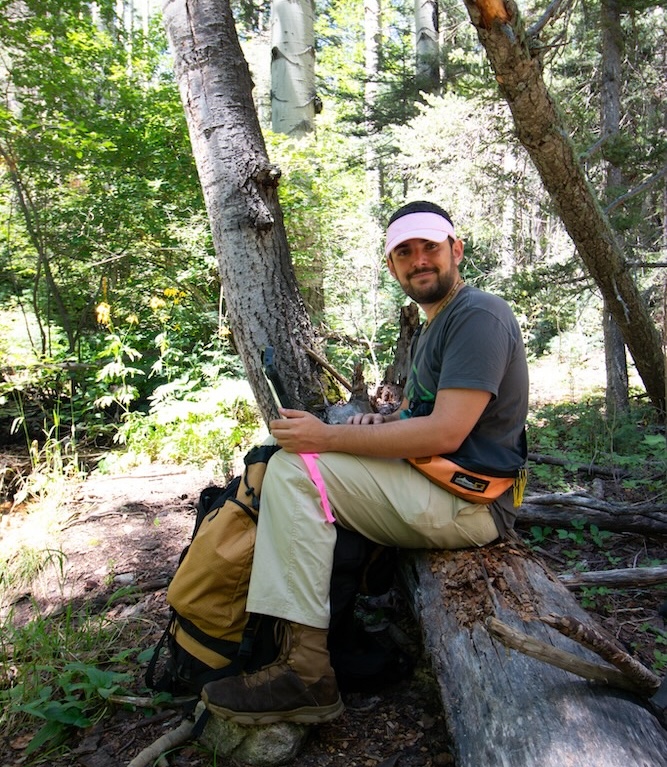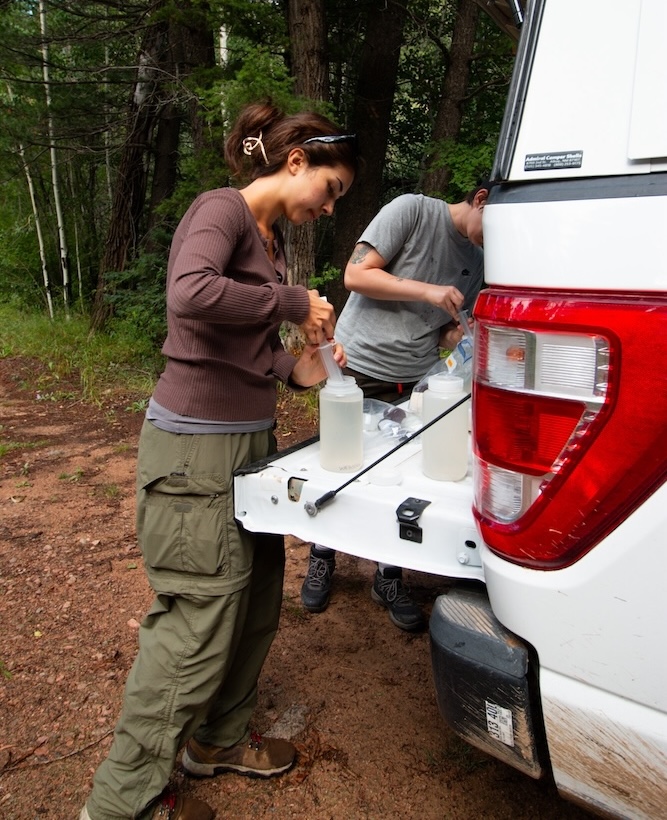By Esther Hewitt, Transformation Network Communications Intern
On August 14, 2024, the Transformation Network’s (TN) Program Coordinator and I (the TN Communications Intern) took a field trip to observe the TN-supported research in the Santa Fe Municipal Watershed. We joined Will Mejía and Jazzmyn Luna, PhD students to Dr. Alex Webster, and lab assistant Sa’angna Mi’ila Gollette on their monthly trek up the mountain to collect water samples at strategically selected sites throughout the watershed.

The Transformation Network Program Coordinator, PhD students Will Mejía and Jazzmyn Luna, and lab assistant Sa’angna Mi’ila Gollette collect water samples in the Santa Fe Municipal Watershed. (Photo by Esther Hewitt)
The City of Santa Fe averages around 30-40% of its water budget from the Santa Fe River, but in 2023, the watershed produced 52%. Forest management practices commonly focus on fire suppression, which ultimately creates an environment with a build-up of biofuel. However, fire suppression practices combined with climate change are increasing wildfire risk. Alex Webster’s team is collecting data to inform management practices. For example, before a fire, the information is relevant to which parts of the watershed should be prioritized for fuel reduction, such as forest thinning or beaver reintroduction. In the event of a wildfire, the data will guide where activities such as tree planting and erosion control should be prioritized.
The quality matters because cleaner water is easier and cheaper to make available for drinking water. Large amounts of sediment, ash, organics, and nutrients from a fire could cause difficulties for a water processing plant unaccustomed to such loads. Alex Webster’s team is assessing the nutrient and sediment loads and quantity within streams across different parts of the watershed and identifying patterns in their adjacent terrestrial catchments. This type of framework has not been implemented in management practices before. It is a new way of looking at resource management by providing information that could inform ways to prioritize watershed resilience and recovery before and after a fire. Will explained that, for example, if the western side produced high hydrological and high-quality outputs, initial efforts could be focused in that area to minimize the loss of crucial outputs following a potential wildfire.
We started our day in Albuquerque at 6 am and ended in the same location 12 hours later, but Will and his team would spend the night in a yurt and finish their collections at another site the following day. We spent over seven hours hiking past the last point we could drive in an area of the watershed only accessible to researchers, so everything necessary for the day had to be carried in large (heavy!) backpacks, including an orange bucket from Home Depot. The barely marked trail led us through fields of wildflowers, groves of pine trees, and up one brutal switchback that made me question my health and fitness level. We ate lunch near a hollow full of waist-high ferns, and we gave Will a minor panic attack when we wandered out of earshot, and he thought we were lost. He kept close tabs on us after that, and we tried much harder to behave.
We collected water samples that were taken back to UNM and sent for analysis to a collaborator at the University of New Hampshire. We also determined streamflow at each sampling point. The work the students are doing is impressive, both for its potential for tangible community impact and for the level of stamina and precision it requires. We were thrilled to tag along for a day and left with much respect for the process and the dedication of the TN team involved in the project.

TN-funded PhD student, Will Mejía, takes a break to each lunch and set up equipment during field work in the Santa Fe Municipal Watershed. (Photo by Esther Hewitt)

Lab assistant Sa’angna Mi’ila Gollette processes water samples on the back of the team’s work truck in the Santa Fe Municipal Watershed. (Photo by Esther Hewitt)